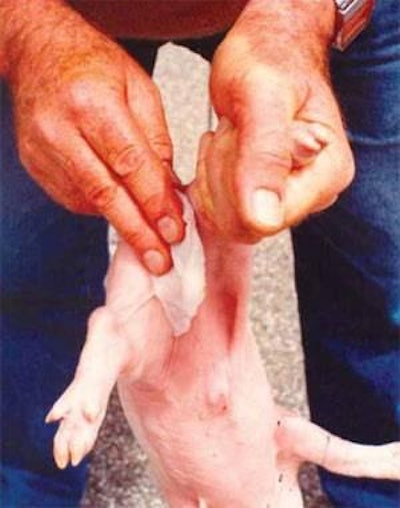
Castration of male pigs destined for pork production is a routine practice in most countries. It is used to prevent boar taint, a urine type of smell in the meat from intact male pigs. Millions of male piglets are being castrated surgically each year without the use of anesthetics. However, this is seen increasingly as a serious welfare issue. Norway and Switzerland have decided to ban castration and several other countries are considering a similar course of action.
Although castration has been effective in solving the boar taint problem, its big disadvantage was always the reduced efficiency (poorer feed conversion ratio) of the castrates and the associated negative environmental impact. Raising intact males improves feed conversion efficiency by 12% and increases lean meat yield by 6.5% compared to raising castrates. A Canadian report 10 years ago calculated that this would mean a saving of US$3 per male slaughter pig at 105kg, rising to US$6 for a pig marketed at 115kg. Internationally, slaughter weights show both a wide range and an upward trend to heavier pigs that will further increase the value of growing boars.
There is an urgent need to use alternative methods to control boar taint, to stop castration and to win the benefits of the more efficient growth of boars. Several solutions can be considered. The first of these is to slaughter boars at a younger age. This would only reduce the taint problem, not eliminate it, but the main problem is the reduced efficiency/higher cost of meat production associated with lower slaughter weights. Wherever boar taint is considered to be an issue, it limits further increases in carcase weight as an opportunity for decreasing costs of production.
Chart 1: Percentage of pigs with a potential boar taint problem
The second option is so-called immuno-castration as developed in Australia. This involves a vaccine that is given during the finishing period to prevent the pig depositing taint compounds in its tissues. The cost of vaccinating is not an issue if producers are willing to pay for a solution to taint and they also gain from rearing intact male pigs, but there are still questions (in Europe in particular) over the acceptability of the vaccination as a solution to a welfare problem.
Genetics offer a third choice. We could develop breeds/lines that eliminate boar taint. In fact, a genetic answer is within reach. A research group at the University of Guelph in Canada, led by Dr Jim Squires, has developed and validated a number of genetic markers that can be used to tackle the taint problem. This work has made available a panel of 32 markers and the plan is to extend that number to about 100 markers, based on perhaps 25 genes that are somehow taint-related. The most effective set from this panel of markers can be selected for application in each breed or line of a breeding programme.
Pig breeders are in a position to apply effective markers within the next 2 years and to develop low-taint products. They will need to validate the markers in their own lines, evaluating the impact on taint compounds androstenone and skatole as well as on growth performance traits and reproduction. After that they can identify parents with a low boar taint marker genotype and produce progeny to test the economic value of the low-taint technology.
At the research phase, there remains the objective of producing an even more powerful genetic solution to boar taint problems. The markers found so far are more effective in some lines than in others and thus do not solve the taint completely. The next step will be to develop more markers in the genes that have given significant effects in some lines and to pick for each line the combination of markers that gives the strongest association. New candidate genes and genetic markers for boar taint will also be investigated.

















